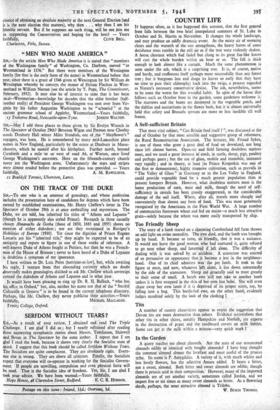COUNTRY LIFE
IT happens often, as. it has happened this autumn, that the first general frost falls between- the two brief interpolated summers of St. Luke in October and St. Martin in November. It changes the whole landscape, and may produce an oddly dramatic event. As the misty air of morning clears and the warmth of the sun strengthens, the heavy leaves of some deciduous trees tumble in the still air as if the tree were violently shaken. A horse. chestnut which had faded but clung to its great fan-like leaves will cast the whole burden within an hour or so. The fall is thick enough to look almost like a curtain. Much the same phenomenon is seen under the ash, which is a surprising tree. It -is, of course, native and hardy, and reaffOrests itself perhaps more successfully than any forest tree ; but it burgeons late and drops its leaves so early that they have no time to pass their chlorophyl back into the twigs, a process regarded as Nature's necessary conservative device. The ash, nevertheless, seems to be none the worse for this wasteful habit. In spite of the havoc that follows such an October frost in the garden, some gardeners welcome it. The marrows and the beans are destroyed in the vegetable patch, and the dahlias and nasturtiums in the flower beds, but it is almost universally held that celery and Brussels sprouts are more or less inedible 'till well frozen.










































 Previous page
Previous page